Welcome to this year’s worldwide report based on the 24,576 responses to the Gender Census, which ran from 12th February until 7th April 2020.
You can see the spreadsheet of results in full here, which might be helpful if you need to see graphs or figures in more detail. (Warning: It’s big and slow!) For the charts and graphs of statistics over time, the summary spreadsheet can be found here.
Q1. Identity words
As usual, I asked: Which of the following best describe(s) in English how you think of yourself? Participants were invited to choose from a checkbox list of 30 words or phrases, and then given textboxes to type in up to 5 more words and phrases.
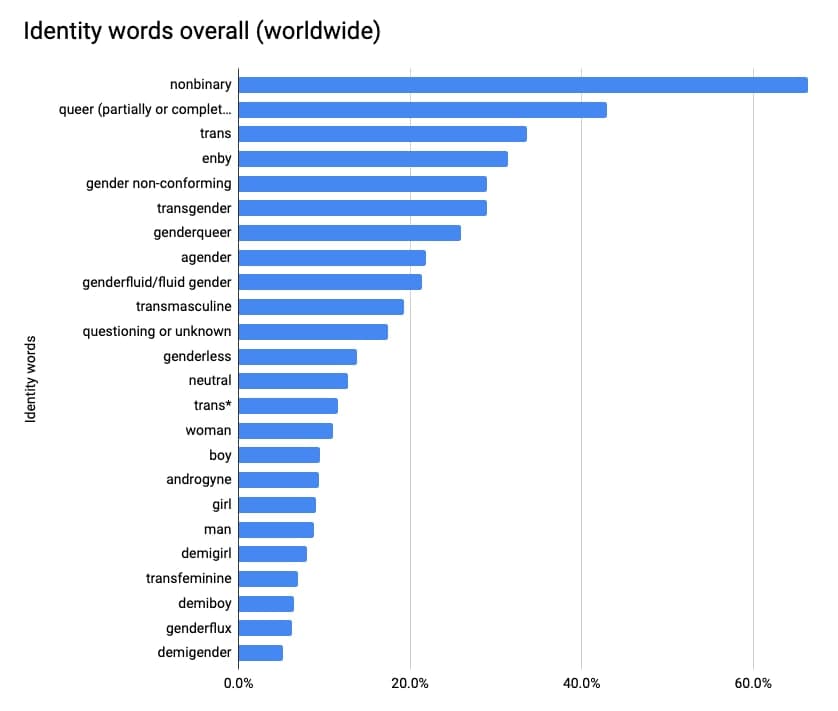
Here’s the top 5:
- nonbinary – 66.4% (down 0.2%)
- queer (partially or completely in relation to gender) – 42.9% (down 0.1%)
- trans – 33.7% (down 2.9%)
- enby – 31.5% (down 0.2%)
- gender non-conforming – 29.0% (up 2.8%)
This year I asked people’s ages so that I could ensure that I wasn’t alienating potential participants by removing checkbox terms favoured by those over 30, which means I can make a graph that looks like this:
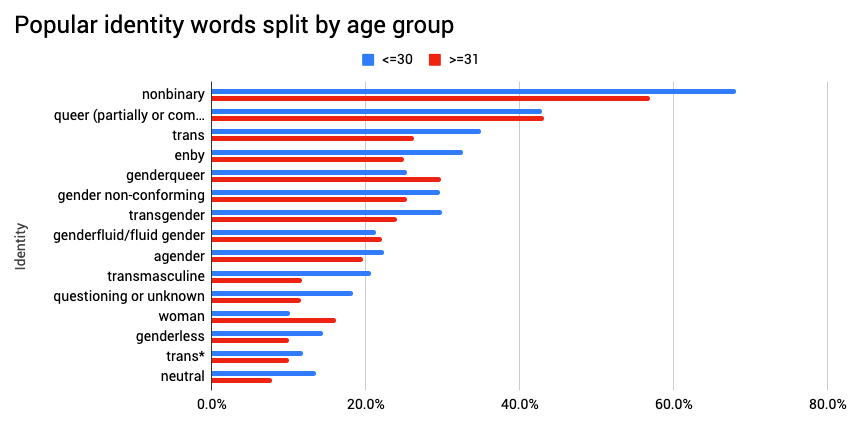
Under-30s are more likely to identify as transmasculine, whereas over-30s are more likely to identify as woman. As I expected, genderqueer is a little more popular among over-30s – I’m in my 30s and was introduced to the term genderqueer first, when I was just starting to figure out my gender stuff in my early 20s.
Here’s the popularity of the top 10 words since 2015:
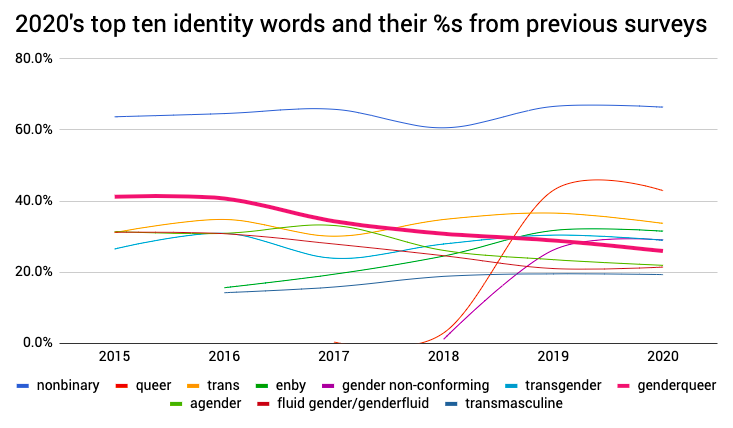
Notable shifts include queer rocketing to second place when added to the checkbox list and so far maintaining at just over 40%, and a gradual decline in popularity for genderqueer (bolded), from 41% to 25% in 5 years.
Last year I decided that I would remove terms from the checkbox list that were chosen by under 3% of participants in both the over-30s and under-30s group and that didn’t correspond with other more popular terms on the list. This year one term met the criteria: third gender. It has been on the checkbox list since the first survey, probably originally added because someone suggested it while I was haphazardly putting the Google Form together. I looked into the phrase a little more last year, and most of my research suggested that it’s essentially a term used by white anthropologists to describe non-straight-non-cis people in non-Western societies. That could include LGB people and binary trans people, in addition to people whose genders are not described by the M/F binary. Although I can absolutely see how third gender as an identity term could have evolved naturally and independently of the anthropological context, I could find very little on the use of the term third gender within the LGBTQ+ community, and wasn’t sure what to make of that. I am interested to find out how many people type it into a textbox when it’s not on the checkbox list.
As always, the write-ins were fascinating to sort! 3,546 unique words/phrases were typed into the textboxes, and of those 747 were entered more than once.
The following words were typed in by more than 1% of either under-30s or over-30s, and so will be added to the checkbox list next year:
- lesbian (277 people; over 1% of under-30s)
- butch (278 people; over 1% of under-30s)
- femme (252 people; over 1% of over-30s)
Butch and femme are familiar and gender-related words to me, but lesbian took me by surprise because I’ve almost exclusively seen it used to describe sexual orientation. I am interested in the blurred line between sexual orientation and gender so I’m curious to see how this plays out over the next few years.
As with queer, when I add it to the checkbox list I’ll add clarifying text to make sure I’m collecting the kind of data I want: lesbian (partially or completely in relation to gender)
And, because I want to be able to compare, I will add the corresponding term: gay (partially or completely in relation to gender). I talked about this in another post, and was asked if I would also add bisexual to the checkbox list. After some thought I’ve decided that I won’t, for two reasons:
- When people were typing lesbian into the textbox, they were often writing something like lesbian – yes, as a gender identity. In contrast, no one out of >24,000 respondents typed in bisexual. In previous years when anyone wrote bisexual they didn’t type any clarification, which means I have no way of knowing whether they meant it in the sexual orientation way or the gender way.
- Lesbian and gay tend to be associated with women and (historically) men respectively, meaning they are tied in some way to gender identity, whereas bisexual quite progressively has no gender connotations at all. The survey’s focus is gender identity so including sexual orientation words that have no gender connotations isn’t something I want to do unless people start typing it into the textboxes and expressing that it is part of their experience of their own gender.
All of this means that next year the checkbox identity list will increase to 33 terms. People are already struggling to find the terms that describe them, especially as I have to randomise the list for every participant to counter any primacy and recency bias. If there are no terms to remove next year with this new 3% boundary I will consider raising it to 4%. I will also need to commission a special question format for the survey to make it easier for people to find the words they identify with – more on that later.
I’ve written more about the responses to the identity question here.
You may also be interested to see a little analysis on enby and its age connotations here, though we will need to investigate this over several years before we can draw any solid conclusions.
Q2: Titles
I asked, Supposing all title fields on forms were optional and write-your-own, what would you want yours to be in English? I also clarified that participants should be currently entitled to use it, so they should have a doctorate if they choose Dr, etc.
There were 5 specific titles to choose from, plus a few options like “I choose on the day” and “a non-gendered professional or academic title”, and an “other” option with a textbox. Participants could choose only one, with the goal of finding out what, when pressed, people enter on official records forms and ID.
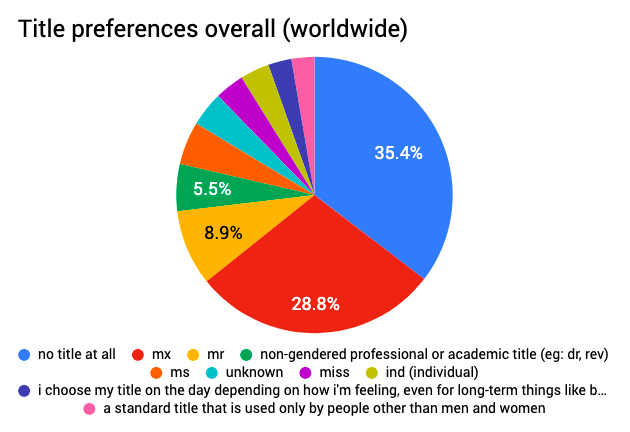
Here’s our top 5:
- No title at all – 34.4% (up 1.4%)
- Mx – 28.0% (down 3.3%)
- Mr – 8.6% (down 0.1%)
- Non-gendered prof/acad. – 5.3% (down 0.2%)
- Ms – 4.9% (up 0.2%)
When you look at the age split, there’s not a huge amount of difference – though Mx is a little more popular among under-30s, and a lot more over-30s prefer no title at all.
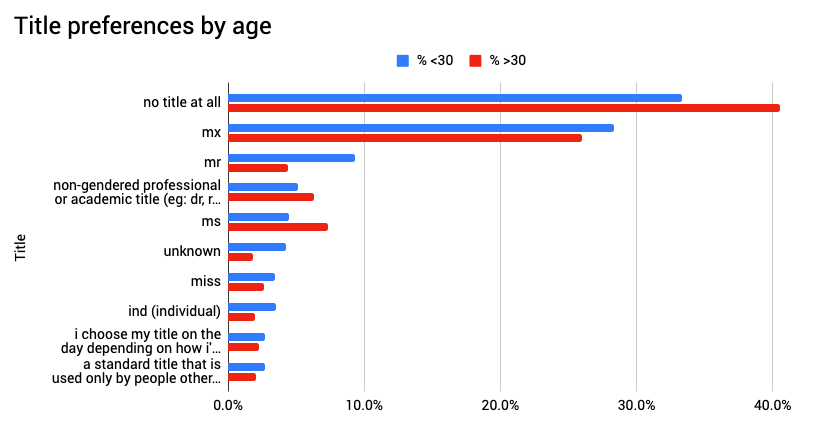
Here’s title popularity over several years:

I find myself wondering why Mx is less popular and no title is more popular over the last two years, with the gap widening, and anything I come up with will be pure speculation, but I think it is worth noting that participation has increased dramatically over the past 2-3 years, which has brought with it a higher proportion of international respondents. Mx is more popular in the UK, and the proportion of UK participants has been dropping as the number of participants has increased:
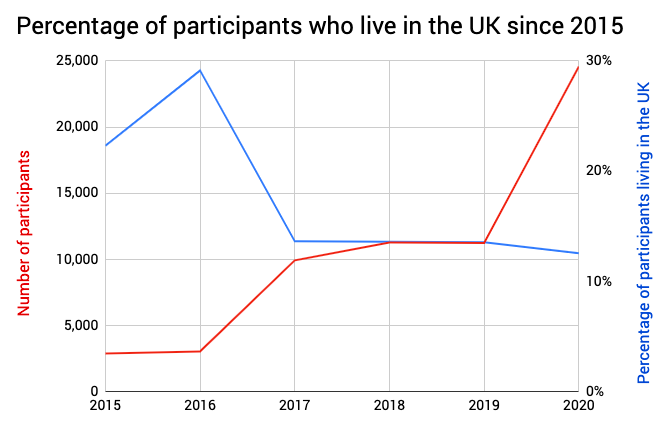
We’ll know more if I manage to write up a UK-focused report this year. [Edit: UK report 2020.]
It’s hard to see if any lesser-used titles are increasing in popularity, since all those titles that aren’t Mx or no title are all bunched up at the bottom of the graph. I find it helpful to space things out a bit by making a second graph that omits Mx and no title:
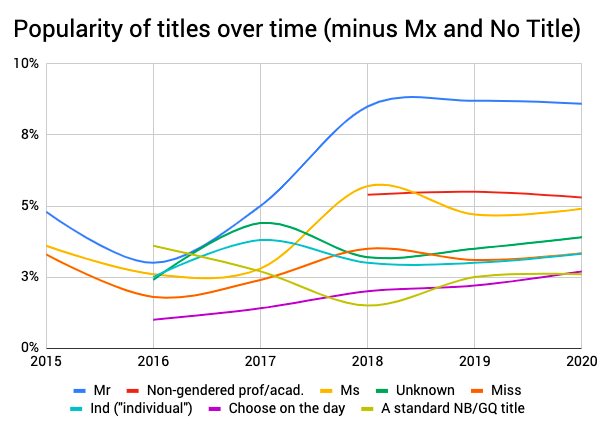
This lets us see that Mr, non-gendered professional/academic titles (Dr, Rev, Capt, etc) and Ms are all still the next three most popular, as they have been for a while. This year nothing else went over 4%, including the well-established titles Miss and Mrs.
It also reveals that while everything else is still quite up-and-down, “I choose my title on the day depending on how I’m feeling, even for long-term things like bank accounts” has been increasing pretty steadily since it was added as an option in 2016.
The top five “other” textbox options entered were:
- M – 50 (0.2%)
- Mrs – 46 (0.2%)
- Comrade – 19 (0.1%)
- Mz – 17 (0.1%)
- Ser – 11 (0.0%)
As in previous years, I invited people who chose “a standard title that is used only by people other than men and women” (2.6% of participants) to optionally suggest titles that they’d heard of. The goal is to find a popular title that is considered exclusive to nonbinary genders the way Mr is generally considered exclusive to men and Ms is to women.
641 people checked the “standard exclusive nonbinary” title option, and here’s everything entered more than once:
- Mx (26)
- M (4)
- Friend (2)
Mx is generally considered gender-inclusive by people who are familiar with it, especially if their title is Mx, but it’s high on this list because Mx is very well-known generally and there are bound to be a few people who didn’t see it in the list and/or consider it to be a nonbinary-exclusive title.
M in French is masculine, but in English it’s not gendered and I assume it’s pronounced “em”? (That seems to be what people have said in the notes, but please do tell me if I’m wrong!) It was also the most entered title in the “other” textbox. I feel a bit iffy about this one because it can be confused for a first initial, but I may be over-worrying there, since France gets along just fine.
You can see the individual report on the title question here.
Q3: Pronouns
This was actually a complex set of questions, starting with Supposing all pronouns were accepted by everyone without question and were easy to learn, which pronouns are you happy for people to use for you in English? This was accompanied by a list of pre-written checkbox options. It included “a pronoun set not listed here”, and if you chose that it took you to a separate set of questions that let you enter up to five additional pronoun sets in detail.
This year, the top five pronouns (or lack thereof) were:
- Singular they – they/them/their/theirs/themself – 77.5% (down 2%)
- He – he/him/his/his/himself – 30.5% (down 0.3%)
- She – she/her/her/hers/herself – 29% (no change)
- None/avoid pronouns – 13.7% (up 3.4%)
- Xe – xe/xem/xyr/xyrs/xemself – 7.4% (up 0.2%)
Singular they continues to be the most popular pronoun among survey participants, greater than the two runners up (he/him and she/her) combined. 14.3% of participants wanted people to mix it up a bit, and 9.1% of participants were okay with any pronoun set. 9.1% of participants didn’t want to be referred to by he/him, she/her, or they/them. 6.3% of participants didn’t select or enter any specific pronoun set at all.
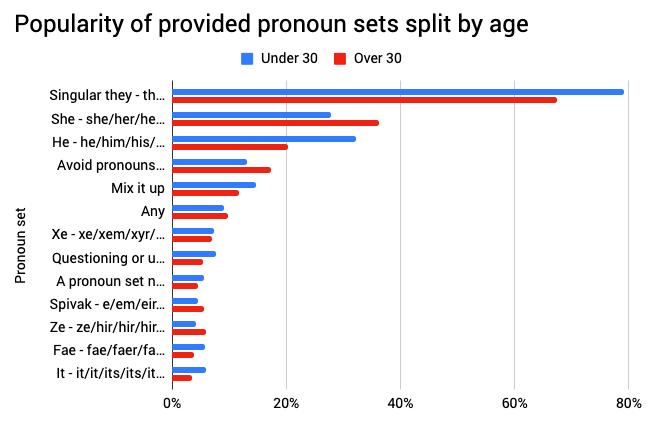
The most striking differences are that under-30s are more likely to go for singular they and he/him, whereas over-30s are more likely to go for she/her or no pronouns at all. Overall pronoun preferences are more or less well-matched between age groups.
Here’s how this year’s pronoun responses fit into the bigger picture:
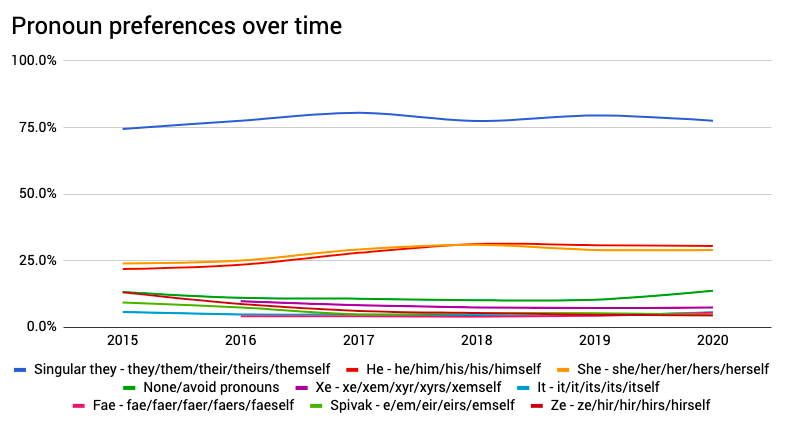
That’s singular they in blue at the top, holding steady at just over 75% even when the number of participants more than doubled this year, and she/her and he/him are still in joint second place at about 30% each.
All of those other pronouns get a bit lost, so here’s the same chart with singular they, he/him and she/her removed, to give the rest a bit of room to breathe:
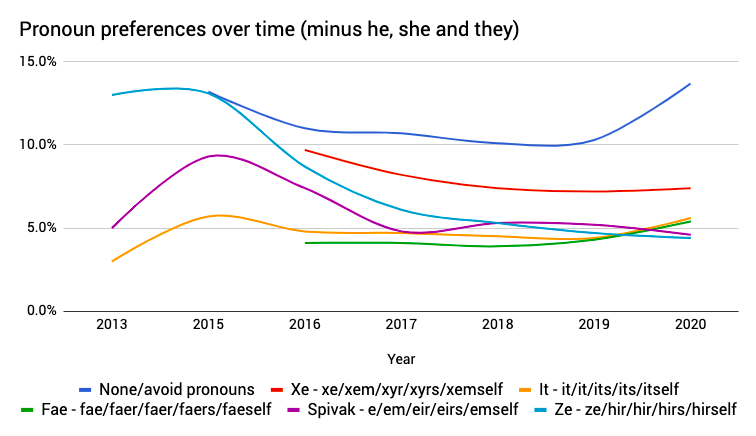
Most pronouns are well within a 5% margin of wobble, with the exception of ze/hir, which has been steadily declining since the Gender Census began and has dipped from 13% to 4%. I had privately wondered whether ze/hir might be more popular among the over-30s, because I remember it being the go-to neopronoun in my social circle around 10 years ago, and it is a little more popular with over-30s compared to under-30s (6% and 4% respectively).
Here’s a graph showing the number of pronoun sets people were selecting and entering:

That’s 1.7 each, on average. Most people (43%) went by only one set, and 33% were happy with two sets.
Every pronoun in the checkbox list was selected by over 4% of participants in at least one of the two broad age groups, so nothing will be removed from the pronoun list next year.
Neopronouns
The most popular neopronoun is in the checkbox list: xe/xem/xyr/xyrs/xemself, at 7.4% of participants.
For the top five typed-in pronoun sets, I’ve taken into account only the subject and object forms:
- ey/em – 0.6% (142 participants)
- ae/aer – 0.3%
- they/them – 0.3%
- ve/ver – 0.2%
- ze/zir – 0.2%
Part of why I love running this survey year on year is I get to explore which neopronoun sets have an approximate consensus on how exactly to use them. The most popular typed-in neopronoun set this year would be:
I’m in a coffee shop with my friend Sam. Ey is buying emself a coffee in eir reusable takeaway cup. “Is this your coffee?” the barista asks me, holding up Sam’s coffee. “No,” I reply, pointing to Sam, “it’s eirs.”
The reason I don’t take into account more forms of the pronoun or whether it uses singular or plural verbs is because there is so much variation that each pronoun gets split into several sets, such that it becomes impractical to work out whether any pronoun is entered often enough that it should be added to the checkbox list. I’ve noticed a lot more variation in the possessives (possessive determiner and possessive pronoun, eg: his, hers, their, etc.) and reflexives (”[pronoun]self”), which is why I tend to leave them out when counting to find broad patterns. I go into more detail on neopronouns and how I count them in the individual report on the pronoun question here.
Even when you combine every set that begins with the most popular first two forms (ey/em) it only totals 142, which is under 1% of participants, so there will be no neopronouns added to the checkbox list next year.
Counting by subject/object/reflexive, there were 768 different pronoun sets entered, of which 165 were entered more than once (about one neopronoun in five). One person in 19 entered at least one new neopronoun set, and overall they provided one unique neopronoun set for every 32 participants.
I haven’t commented on nounself pronouns thus far because I didn’t really have anything to say and they’ve been relatively rare from the start. They continue to be rare, and I haven’t been making graphs of them but I think they’re getting rarer. (Nounself pronouns are pronouns derived from nouns, one of the more well-known being pup/pup/pupself.) So, nounself pronouns are [maybe on their way] out, and… emoji pronouns are in?? A handful of participants entered pronoun sets such as 👁/👁/👁self (singular verbs), and there weren’t many, but there were more than last year, and I’m always interested to watch these things from my Big Picture perspective. I can’t imagine using them myself because it seems like it would be very impractical to switch between standard and emoji keyboards so much and pronunciation could be complicated to communicate, but I love that people mess around with language like this. You gotta keep things linguistically wiggly, to allow people the space to play and figure out what makes them happy.
You can see the individual report on the pronoun question here.
Age and referrers
These two topics get combined into one section, partly because they’re each quite short and partly because when you combine the statistics you get some fun and useful conditional formatting information out of it.
Here’s our age distribution:
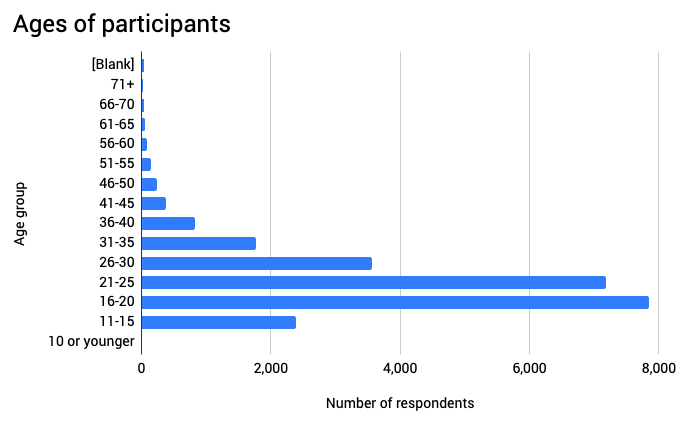
The first time I asked about age, I made the question compulsory and required an exact age. This time I made the question optional, and allowed people to be a little more vague about their ages, and I think that was a good call, since clearly the vast majority (99.87%) of participants were happy to give me an age range. I will continue to ask about age in this way in future.
Only 14.5% of participants were 31 or older. (For context, in the UK in 2011 about 62% of the general population was 30 or older.)
And here’s a graph of places people found out about this year’s survey, which includes every place entered by over 1% of participants:
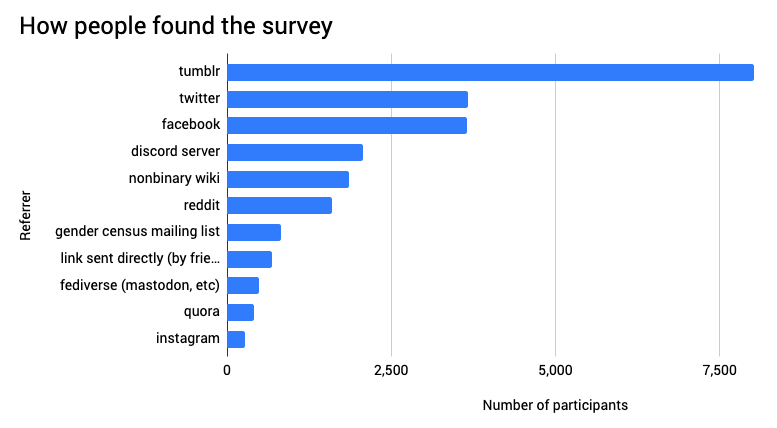
That’s 32.6% from Tumblr, followed by Twitter and Facebook at about 15% each. 62% of participants came from one of the big three, and that’s actually fewer than I was expecting.
The age distribution graph above is very similar to the age distribution of the userbases of those three websites, which tend to skew younger than the general population, especially on Tumblr.
When I compared ages of participants and the places they found out about the survey, I got this:
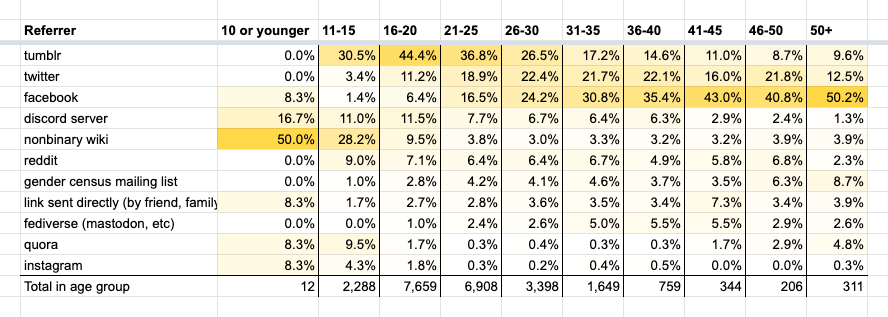
This is basically a heat map, and it’s a little difficult to read because the text is so small – if you want to look at it in more detail or you use a screenreader I recommend clicking through to the original on the Google Sheet. As a vague description: Tumblr’s referrals are mainly in the 11-30 range, with most being 16-20. Twitter’s were mainly in the 21-40 range, with most being 26-30. Facebook is mainly 26 and older, with a general trend towards older people being more likely to come from Facebook. Most people under 15 came from Tumblr, very closely followed by the Nonbinary Wiki – maybe younger people researching to find out how to describe themselves? After that, other sources are generally hovering around or below 5% for each age group.
I primarily made this table to find out where participants in the older age ranges are coming from, so that I can make sure to keep those channels of communication open where possible. A surprising number came from Quora, and based on some of the type-ins it looks like Quora has a nonbinary club/space/group where the link was shared? (I know nothing at all about Quora.) And in the 71+ category, after Facebook the most popular method was the official Gender Census mailing list.
For older internet users who are less au fait with social networks, email is an established and easy way to stay in touch. I am reassured that maintaining the mailing list is the right way to go. Even if it ends up being expensive, word of mouth and email will be a strong way to reach potential respondents over the age of 50. (Facebook is too, but I’m not confident that a Facebook presence would help the Gender Census, I’d be worried about my own privacy online, etc. Individuals sharing the link on Facebook in groups and one-on-one seems to be working quite well.)
Unless anything particularly different or interesting happens with age/referral, in future reports I will stick to a brief summary of age distribution of participants.
The questions I ask
- What should the third gender option on forms be called? – Still no consensus, but nonbinary is at 2 in 3 people and it does seem to be gradually climbing. Certainly nothing else is climbing in a way that suggests to me it could replace nonbinary.
- Is there a standard neutral title yet? – Not yet. Mx is still consistently far more popular than all other titles, but just as many nonbinary people want no title at all. It’s really important that activists campaigning for greater acceptance of gender diversity remember to fight for titles to be optional, too.
- Is there a pronoun that every nonbinary person is happy with? – No. The closest we have to a standard is singular they, and it’s important for journalists and anyone else with a style guide to allow it. Steadily over the last few years about 1 in 5 are not into singular they, and 9% of us don’t like he, she or they pronouns.
- Are any of the neopronouns gaining ground in a way that competes with singular they? – No. This year the closest is “Xe – xe/xem/xyr/xyrs/xemself” (7.4%, compared to singular they’s 77.5%). Users of these neopronouns will probably not reach consensus for many years – language and especially pronouns as a closed class can be very slow to settle and gain ground. Even if one neopronoun does become very commonly used, many will continue to use other neopronouns for a long time to come.
This year in review
The most striking thing this year was the huge increase in participation. Last year was the second with about 11,000 responses, and this year there were well over twice as many. At one point there was so much going on that I reached the limit of 5 million cells on Google Sheets, and had to put a lot of work into making the formulae more space-efficient…! I’m actually a little bit nervous about what happens if the survey responses increase so much that it won’t fit onto one Google Sheet…
The crowdfunding was successful and fast again this year (three hours!), which was a relief, and I’m really grateful to those of you who joined in with funding and promotion – thank you!
I also decided to directly address the tendency for gender-critical feminists to join in with the survey, often with the attempt to disrupt, and often giving answers consistent with nonbinary and agender participants. (In short, anyone failed by the gender binary can take part as long as they’re talking about their own experiences of their genders or lack thereof and they’re not being abusive. Deliberately disruptive responses are removed.) I got a mixed response to that, and I can understand why – it’s a topic that makes me feel very uneasy, and it’s a hard area to navigate. I recommend reading the article on this decision here for more nuance than I can include in this report.
This year I managed to put a little more focus on promoting the Gender Census in offline spaces, by giving people printable flyers that they could distribute for the duration of the survey and at other times of year. A few participants said they discovered the survey by picking up a flyer in a queer bookshop in Scotland! So I’m pleased with how that turned out, and it seems like a good way to draw in people who are not on social networks as much and would otherwise not find out about the survey. I will continue to put work into this method of promotion, and if you would like to download and print some flyers to include in zine envelopes and eBay sales and whathaveyou, you should be able to use this Google Doc even if you don’t have a Google account.
Writing up the report has been slow, and has happened in bitesized chunks, for various reasons. I’ve had a house-move, two new medications for two different conditions that conspired to give me chronic migraines, and… a pandemic… But 2020 isn’t over yet and I made it. Hopefully 2021 will be a little easier! (I hope you and your loved ones are all safe and well, and embracing homemade face mask life where applicable.)
What I’ll do differently next year
- Include links to flyers for people to print and distribute in social media posts and mailing list emails from the start.
- Crowdfund to get a custom question coded for the identity question, so that people can easily filter the long list of answers to find terms that they already know they identify with.
- Change some wording for some answers in the referral question. It’s a relatively new question that needs some honing by trial and error.
And the big announcement, too big to fit into a bullet point: we now have a Patreon project page.
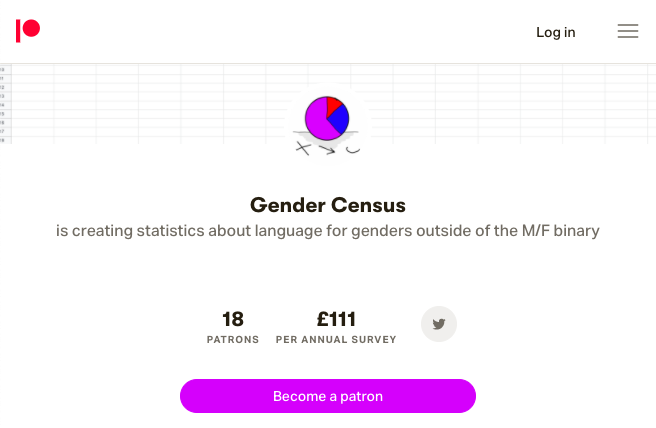
It’s funding per creation (as opposed to per month), which means that once a year when I’m ready to start working on the Gender Census I will hit the big red button to take micropayments from everyone to cover survey costs. If any costs aren’t covered I can run a smaller one-off crowdfund to make up the difference.
It’s a bit like Kickstarter but for regular payments. You sign up and pledge once, and automatically fund projects with micropayments on a regular basis. You can pledge as little as £1/$1/€1 per year, and you can pledge in lots of the more common currencies. In return you can get updates on the project through Patreon. (Some projects also offer patron-exclusive content and rewards.)
If you like the idea of pledging now and getting charged automatically when the survey’s about to kick off, please do take a look at the Patreon project page. And if you’re not into it but still want to support us, don’t worry – following us on social networks and sharing survey/crowdfunding links is still very helpful, and the most important way you can contribute is by participating in the survey itself.
Closing thoughts
I never fail to be blown away by everyone’s generosity in crowdfunding, sharing the survey with friends, and trusting me with information about themselves. I still can’t get my head around the mind-boggling more-than-doubling to over 24,000 of you.
As always, it has been a big nerdy pleasure to mash around with numbers in Google Sheets and read all of your personal accounts of your genders. In addition to embracing my inner (okay, outer) weirdo whose favourite thing is playing with spreadsheets, I get the privilege of really knowing that I’m part of an ever-growing community of people like me. We’re endlessly diverse and yet have so many experiences in common, and it’s fascinating and inspiring and it fills me with hope.
Thank you, to all of you, for everything.
Support me!
Thanks for reading! If you enjoyed it and would like to give something back, you could pledge to support the survey financially on Patreon, or increase your chances of taking part in future surveys by following on Tumblr, Twitter or the Fediverse, or subscribing to the mailing list. Alternatively, you could take a look at my Amazon wishlist.
If you’re in the UK and open to supporting a very topical cause, please do consider signing this petition calling for the UK government to add a nonbinary option to their coronavirus test order form. At the moment nonbinary people must lie to order a coronavirus test online or over the phone, which is illegal in two ways! You can also reblog this blog post.
2020-11-02
2021-04-01: Edited the paragraph about the removal of third gender, to remove negative judgement and to add a little detail about how it was added to the checkbox list in the first place.
email: hello@gendercensus.com